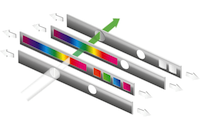Members Login

Channels
Special Offers & Promotions
Patent for Linear Variable Filters in Microplate Readers Granted to BMG LABTECH
BMG LABTECH, a leading manufacturer of microplate readers, announces that the company has received grant for the U.S. Patent 9,733,124, entitled “Microplate Reader with Linear Variable Filter”.
 The patent’s claims cover a revolutionary new type of dual monochromator technology using Linear Variable Filters (LVF) for the selection of wavelength and bandwidths. The patent provides protection for this unique LVF MonochromatorTM design and recognition of the high quality of the innovation being carried out by the BMG LABTECH team.
The patent’s claims cover a revolutionary new type of dual monochromator technology using Linear Variable Filters (LVF) for the selection of wavelength and bandwidths. The patent provides protection for this unique LVF MonochromatorTM design and recognition of the high quality of the innovation being carried out by the BMG LABTECH team.
The LVF Monochromator technology was first integrated in the CLARIOstar® microplate reader, launched in 2013. The LVF Monochromators are based on Linear Variable Filters, which have variable coatings along their lengths that can reject or pass certain wavelengths of light. A linear variable filter consists of two quarz slides, a linear variable long pass and a linear variable short pass, that when properly aligned separate light into distinct wavelengths and continuously adjustable bandwidths. The CLARIOstar contains two LVF Monochromators, one for excitation and one for emission. In between the two monochromators one can find another unique feature of this system: a Linear Variable Dichroic Mirror slide. This is used to separate the emission from the excitation light.
Since LVF Monochromators separate light differently than conventional grating-based monochromators, they provide significantly higher sensitivity and flexibility for several reasons. First, the transmitting filter design of BMG LABTECH’s LVF Monochromators allows for higher light transmission, by eliminating internal loss of light, caused by the diffraction of the grating. Second, the LVF Monochromator design avoids stray light that occurs with conventional monochromators. Avoiding stray light decreases the background signal and significantly increases sensitivity. Third, the LVF Monochromators have unique continuously adjustable bandwidths from 8 to 100 nm. Larger bandwidths allow more light for excitation and emission, which means greater sensitivity. Fourth, the Linear Variable Dichroic mirror splits the emission from the excitation light, what optimizes the light path and greatly reduces the background signal. And fifth, BMG LABTECH has eliminated the need for fiber optics to guide the light to the microplate well. The optical system of a microplate reader with LVF Monochromator uses a free-air optical path to direct the light, which gives significantly higher transmission and lower background (less autofluorescence).
All these advantages of BMG LABTECH’s unique LVF Monochromator technology lead to unmatched flexibility and sensitivity for fluorescence and luminescence measurements, providing users access to novel life science applications.
Media Partners


